| |
Peru - Nazca Lines, Cuzco, Machu Picchu, Lake Titicaca
Bolivia - Copacabana, La Paz
Chile - Easter Island
January 2017
|
| |
 |
|
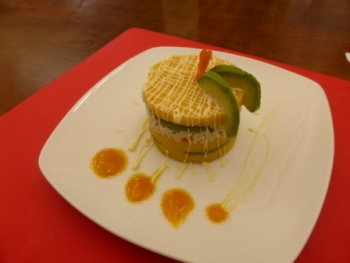 |
| After a morning market tour, followed by a exotic fruits and vegetable sampling, we helped prepare several Peruvian dishes at the Sky Kitchen cooking class in Lima, Peru. |
|
Our first course was causa, made with layers of potato, avocado, chicken, topped with a mayonaise and aji chili garnish. Later we made ceviche (raw white fish, marinated in lime juice), lomo saltado (sauteed beef tenderloin with vegetables) & picarones (donuts made with sweet potato). |
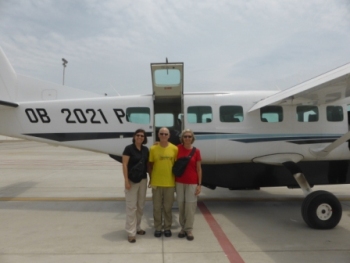 |
|
 |
| Mike, Linda and Vicki climbed into a 12 seater plane to do a fly-over of the Nazca lines, created by indians here before the Incas. The spider is one of hundreds of huge ancient shapes in the desert. |
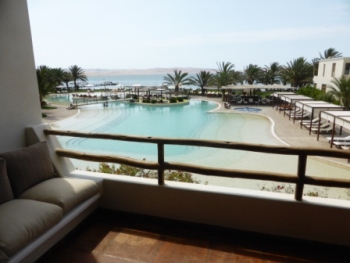 |
|
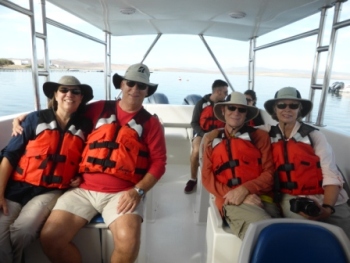 |
| Our hotel in nearby Paracas, La Hacienda Bahia Paracas, was fantastic. This is the view from our room balcony overlooking the 3 pools and the bay beyond. |
|
We left the hotel from the marina to cruise through the Paracas Bay out to the Ballestas Islands. |
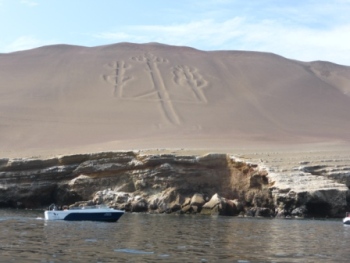 |
|
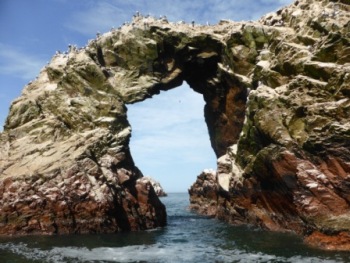 |
| As we passed the furthest point in the bay; we saw The Candelabra, a carving in the side of the rock that is hundreds of years old and has never been restored. This area has less than 1/4 inch of rain each year and is protected from winds by the mountain on which it is carved. |
|
The 23 Ballestas Islands run the length of Peru and are part of the Paracas National Reserve. We saw Humbolt penguins, Peruvian pelicans, sea lions, cormorants, star fish, and many more species. The white covering on the islands is guano, which was exported in the past to use as fertilizer in the USA. |
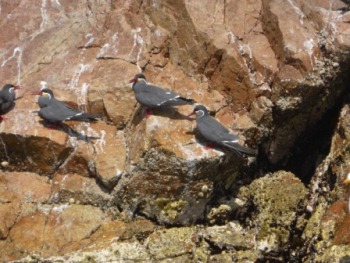 |
|
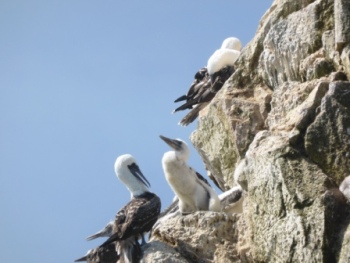 |
| These red beaked and red footed Inca Terns covered the rocks. |
|
Peruvian boobys were feeding their young, fluffy, white hatchlings. |
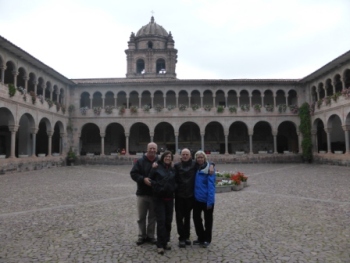 |
|
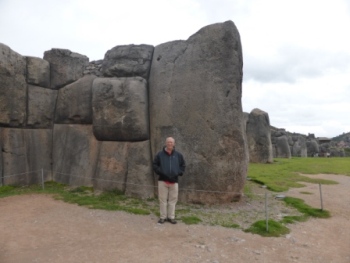 |
| Cuzco was colder than we expected, but the colonial city was beautiful. |
|
Outside of the city, the ruins of Saqsaywaman showed off the skills of Incan builders. |
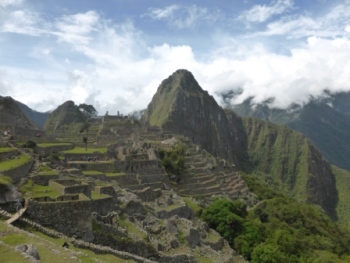 |
|
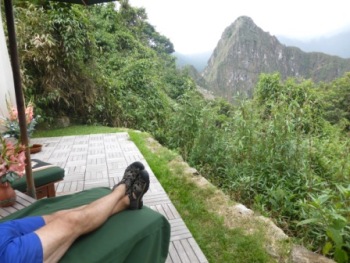 |
| Machu Picchu was a delight. The weather was constantly changing with a light misty rain in the morning that made the sacred Incan site very mysterious. But in the afternoon, blue skies made the green mountain shine. |
|
Paul sat on our Sanctuary hotel terrace and viewed the ruins below. |
 |
|
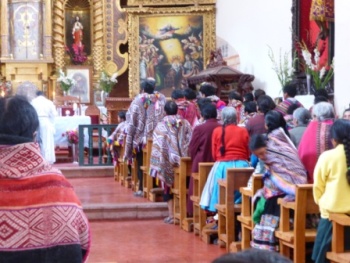 |
| While we visited the Sacred Valley, Vicki tried to learn how to spin yarn by hand from alpaca wool at the Awanakancha wool center. The teacher was patient, but didn't have a good student. |
|
In Pisac, we attended part of a mass in Quechua, the Incan language. The local mayors (city fathers) sat in the front of the church. |
 |
|
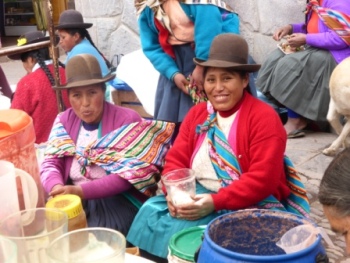 |
| Even though it was Sunday, the Pisac market was hopping. Hundreds of vendors filled the main square. |
|
Several women sat enjoying a homebrewed Inca beer made from chicha. |
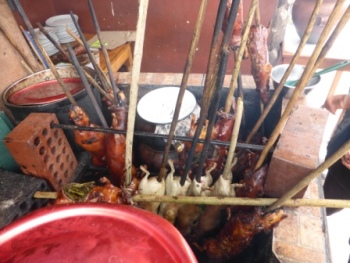 |
|
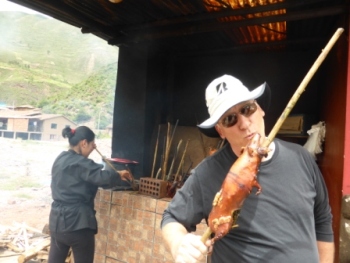 |
| We had to stop for a sample of the best wood roasted cuy (guinea pig) in Peru's cuy capital - Lamay. Dozens of cuy stands lined the main street. |
|
Our guide picked out a nice fresh one, that we shared. It was surprisingly good and tasted like pork roast stuffed with a special spice. |
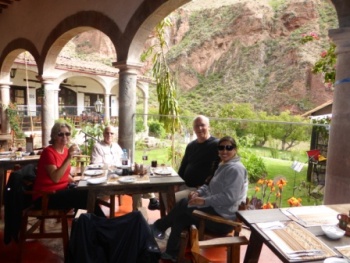 |
|
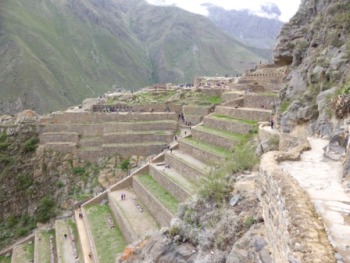 |
| After our cuy appetizer, we enjoyed lunch with our guide, Aracelli, at Tunupa in Urubamba. |
|
Then it was time to get some exercise by hiking to the top of the Incan Sun Palace in Ollantaytambo. |
Restaurant Suggestions:
Lima: Sanguicheria La Lucha, Miraflores: great sandwiches, good prices, lots of locals
Cuzco: Seledonia's Mesa: Calle Chihuampata 564: wonderful experience eating in the family home, great food, wonderful service
Urubamba: Tunupa: fun atmosphere in a colonial manor home, beautiful gardens along the Urubamba river, huge buffet of Peruvian and International cuisine
Puno: Las Arenas del Lago, located between the Sonesta Posada del Inca and the Casa Andina hotels: huge portions of Peruvian local cuisine, Spanish only menu, very good chicharrones of fish, chicken and pork; delicious chicha de quinoa; super cheap - less than $30USD for 6 people with beers & pitcher of chicha
Mojsa, on the Plaza de Armas, beautifully presented dishes, ask for a window view over the plaza, best alpaca steak we had in Peru, nice thin crust pizzas
|
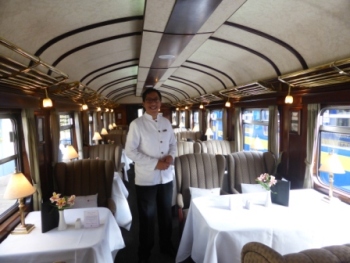 |
|
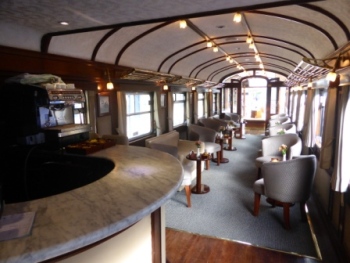 |
| The Andean Explorer was truly a luxury 10 1/2 hour train ride from Cuzco to Puno. Our attendant met us in the dining car where we had a private table. |
|
The lounge car held two performances by local music and dance groups - one from Cuzco and later one from Puno. They also had a Pisco Sour demonstration and tasting followed by a fashion show. |
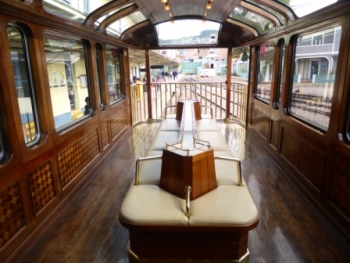 |
|
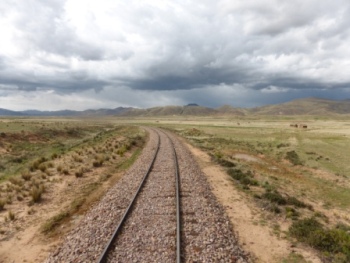 |
| Since there were only 28 people on the train, we were able to take advantage of great views without windows from the back of the observation car. |
|
The altiplano (high plains) of Peru had extensive views to the Andes Mountains on both sides. |
 |
|
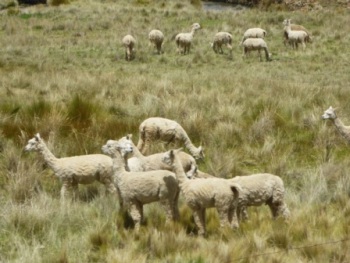 |
| The 3 course gourmet lunch began with a quinoa soup and cheese bread, followed by beef bourguignon or quinoa and vegetables (shown in the picture) accompanied with Chilean wines and then a chocolate tart. |
|
Llamas, alpacas, guanaco and vicuña stood in herds roaming freely next to the railroad tracks. |
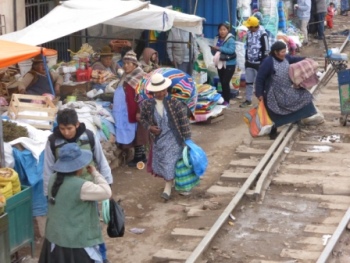 |
|
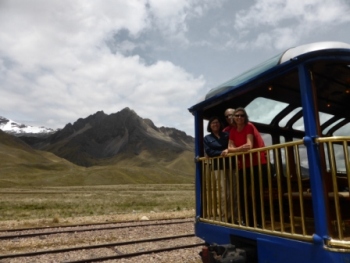 |
| When we entered the town of Juliaca, men and women scurried to clear the tracks where they had laid their wares. |
|
The highest point on the ride was at snow-capped La Raya at 14,150 ft. above sea level. |
 |
|
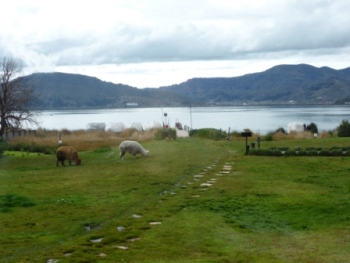 |
| Later in the day we were served high tea with several finger sandwiches and delicious tea made with lemon grass and citrus slices. |
|
Once we arrived in Puno, we looked out of our hotel window to see llamas grazing on the grounds and Lake Titicaca beyond. |
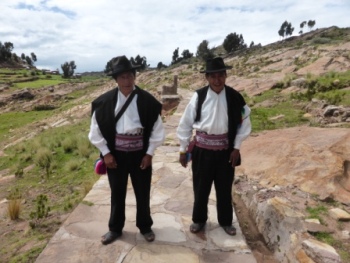 |
|
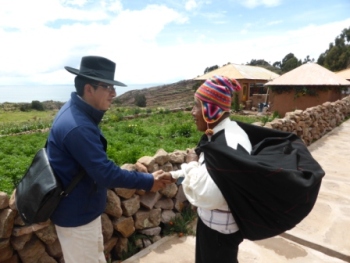 |
| We took a speed boat out to Taquile Island, and were immediately met by two of the local leaders who collected a tax from us. They also offered us coca leaves carried in their hip pouches to chew. |
|
As is the custom, our guide shook hands with each man he passed on the island. |
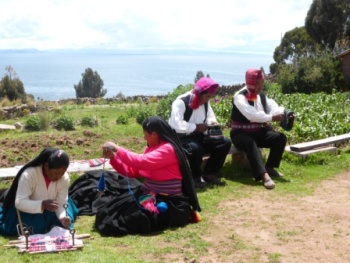 |
|
 |
| Taquile is known for the intricate weavings made here. We saw people spinning and weaving as they walked or sat. |
|
One man was kind enough to pose with us for a picture. |
 |
|
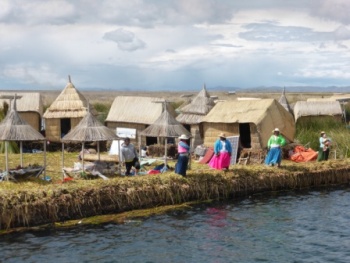 |
| We left Taquile and headed into the reeds in the shallow (up to 10 ft.) part of the lake. |
|
This is the home of the Uros, a pre-Incan people that live in harsh conditions. They live on floating islands that they build themselves, use drinking water from the lake and have no heat in their homes. |
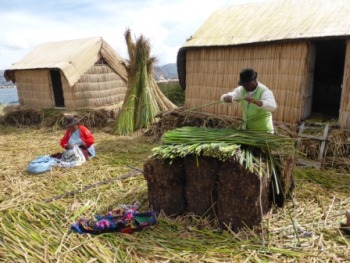 |
|
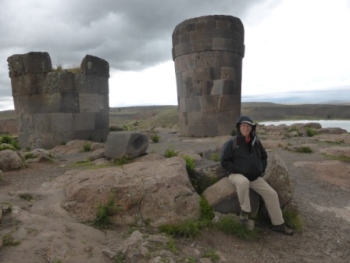 |
| We stopped at an island, home to one extended family. The ground felt like sponge when we stepped out of our boat. The male leader showed us the technique used in building the island, mostly using the reeds and their roots. Then we were able to go inside one of the one-room homes. |
|
The Chullpas of Sillustani were funerary towers housing the remains of ancient nobility. Inside one of the chullpas we saw a rib bone and skull. |
 |
| As we stood by the towers, our guide saw the sky and told us we had to quickly return to our van about a 10 minute walk below. We left right then, but were still hit with hail and rain before we reached the van. |
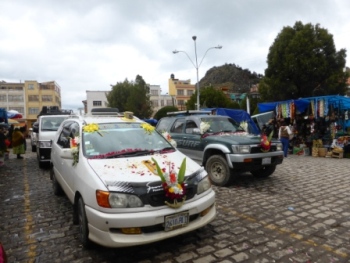 |
|
 |
| We left Peru and entered Bolivia by going through the city of Copacabana, a religious pilgrimage site for Peruvians. Each Sunday, newly purchased cars are decorated and then they are blessed by the priests to protect both the car, driver and passengers. |
|
We left Copacabana on a hydrofoil that got up on its skis as it traveled 45 minutes to take us to the Sun Island on Lake Titicaca. |
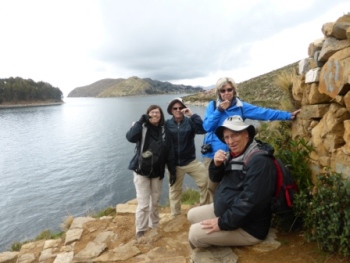 |
|
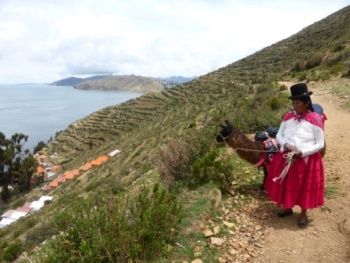 |
| We started hiking up the side of the island to our hotel, but due to the altitude of 12,000 ft. above sea level; we were all short of breath. Our guide gave us wild mint leaves to sniff to help revive us. |
|
We were accompanied by a local woman and her llama that carried our hand luggage, an oxygen tank and a first aid kit. Fortunately, we didn't need any medical attention. |
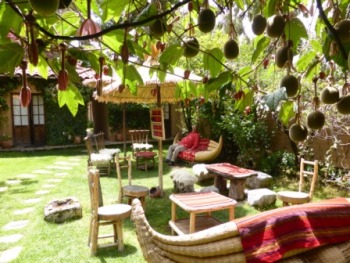 |
|
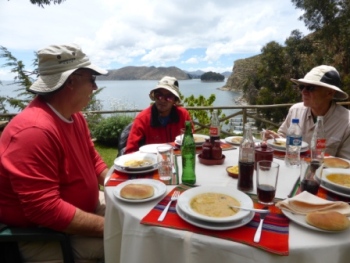 |
| Paul collapsed into one of the reed lounges at the Posada del Inca Eco lodge under the shade of the granadilla vines (a delicious fruit that tastes like a cross between a kiwi and a peach, but is full of grapelike seeds).. |
|
We enjoyed two days of beautiful views, local cuisine and great company on the island. |
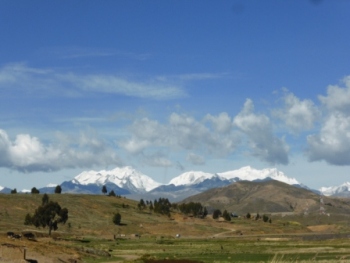 |
|
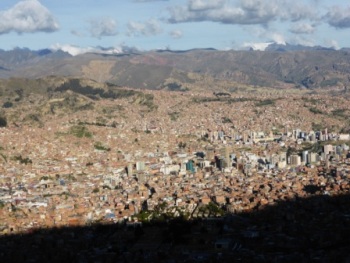 |
| After we took our boat back to the mainland, we could see the snow capped Royal Range of the Andes Mountains on our way to the capital city. |
|
La Paz sits in the valley of the Andes mountains. Our hotel, El Presidente, (the green tall building) was right in the middle of the downtown area. We had a two room suite that overlooked the central square and cathedral. |
 |
|
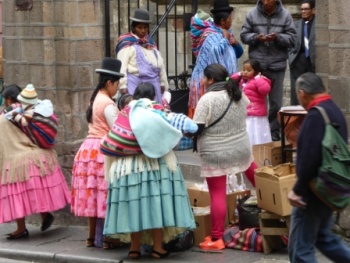 |
| Military bands marched through the city preparing for a national holiday the next day celebrating the founding of the Multi Cultural State of Bolivia. |
|
Families gathered to attend a baptism dressed in their finest. |
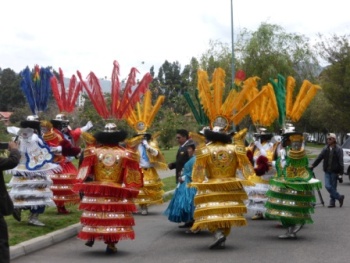 |
|
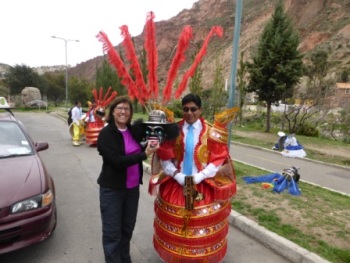 |
| We passed a group of Morenada dancers commemorating the hard working African slaves that were brought to Bolivia. |
|
Vicki was able to hold one of the headdresses and even try it on. |
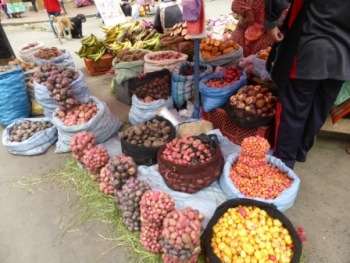 |
|
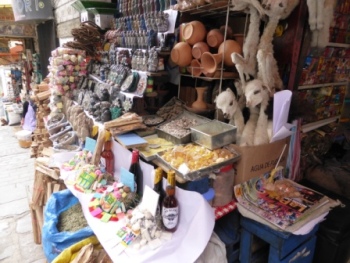 |
| At the large Lanza market in La Paz we saw some of the hundreds of varieties of potatoes grown - from little pink and yellow ones the size of peas to purple, red, orange, nearly black and dried. |
|
The Witches Market displayed llama fetuses, candy, bottles of wine and beer, plus various amulets to be buried in the foundation of a new structure to ensure safety for the workers and future owners. |
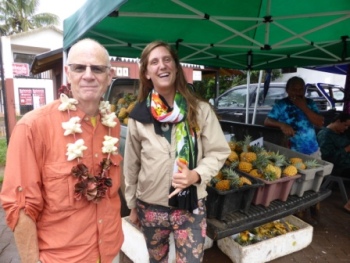 |
|
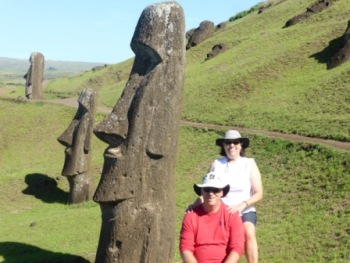 |
| Welcome to Easter Island! All of us were given heys (the E. I. version of the Hawaiian lei) upon arrival. Our guide, Chris, showed Mike the wonderfully sweet pineapples from the island. |
|
The amazing heads of the moai stood in the quarry, ready to be transported to platforms around the island. They were carved between 1,250-1,500 AD. |
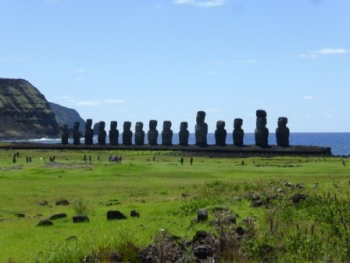 |
|
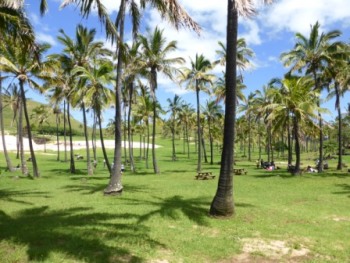 |
| Tribes "walked" them from the quarry in the hills down to the ocean side platforms where they stood as memorials to the ancestors. |
|
Most of the island is treeless, but the beautiful Anakena beach area is full of palms. |
 |
|
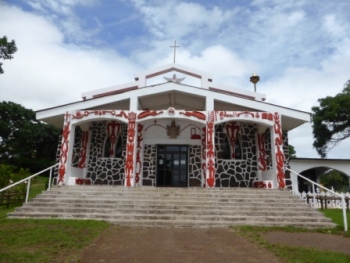 |
| Supersized empanadas about 10 inches long are a staple here. We ordered one filled with pineapple, cheese and shrimp served with a nice chimichurri salsa for $5 USD. |
|
The Catholic church here is a testament to the blending of two religions. Rapa Nui symbols of fertility, bird-man warriors, and other ancient images are mixed with Christian symbols on the front of the church. Blended icons (ie. Mary with a feather head dress and Jesus on the cross wearing a crown of shells and beads) adorn the inside of the church. |
 |
| Paul , Mike & Linda enjoyed viewing this very unpopulated island with lovely landscapes and crashing surf. |
| |